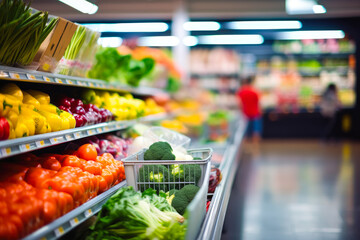Now Reading: Sturdy competition in grocery retailing
-
01
Sturdy competition in grocery retailing
Sturdy competition in grocery retailing

This year grocery industry has went through a lot- from price inflation, shortages of supplies, critical weather conditions to advancement in technology. Though we all know how the recent pandemic impacted the grocery industry, but it had its positive impact as well. It accelerated new innovations in grocery retailing, made people aware of their diet etc. Advancement in technology, in recent years have led to the path for online shopping, inventory management, fastest delivery options and what not.

Intense competition in the grocery retail marketing sector is a common phenomenon, driven by various factors that influence consumer behavior, market dynamics, and industry trends.
Here are key aspects contributing to the robust competition in grocery retail marketing:
1.Market Saturation: Many regions have a high density of grocery stores, with multiple retail chains, local markets, and convenience stores vying for consumers’ attention. This saturation leads to fierce competition for market share.
2.Consumer Choice: Consumers have numerous choices when it comes to where they buy groceries, both in physical stores and online. They can opt for traditional supermarkets, discount stores, specialty stores, farmer’s markets, or e-commerce platforms, giving them significant buying power.
3.Price Wars: Price is a critical factor for consumers when choosing where to shop for groceries. Retailers often engage in price wars, offering discounts, promotions, and loyalty programs to attract and retain customers.

4.Private Label Brands: Retailers increasingly invest in private label or store brand products. These brands offer cost advantages and allow retailers to differentiate themselves, but they also intensify competition with national brands.
5.E-commerce Growth: The growth of online grocery shopping has intensified competition, with traditional retailers and dedicated online platforms vying for market share. E-commerce giants like Amazon and Walmart have expanded their online grocery offerings.
6.Delivery and Convenience: Grocery retailers are competing to offer convenient shopping experiences, including options like same-day delivery, curbside pickup, and subscription services. Speed and convenience are key drivers in attracting and retaining customers.
7.Customer Loyalty Programs: Loyalty programs and rewards are a common strategy used by grocery retailers to retain customers. These programs offer discounts, cashback, and exclusive offers, creating brand loyalty and repeat business.
8.Innovation: Retailers invest in innovation to stand out. This includes adopting new technologies like self-checkout, digital payment options, and smart shelves, as well as introducing novel products and services.
9.Store Experience: The in-store experience, including store layout, product placement, cleanliness, and customer service, plays a crucial role in attracting and retaining customers. Retailers invest in store design and aesthetics to create a pleasant shopping environment.

10.Local and Sustainable Focus: Consumer preferences for locally sourced, organic, and sustainably produced products have led to competition among retailers to offer these options and promote their commitment to ethical and sustainable practices.
11.Marketing and Advertising: Aggressive marketing and advertising campaigns are common in the grocery retail sector. Retailers use various channels, including digital marketing, social media, traditional advertising, and email marketing, to reach and engage consumers.
12.Product Selection: Expanding product assortments to meet diverse consumer preferences and dietary restrictions is another strategy for capturing market share. Offering unique or exclusive products can set a retailer apart.
To succeed in this competitive landscape, grocery retailers must continually adapt to changing consumer preferences, leverage data analytics for personalized marketing, invest in technology and innovation, optimize supply chains, and focus on providing excellent customer experiences both in-store and online. The ability to offer value, convenience, and a strong brand image are key factors that help retailers thrive in the face of sturdy competition in the grocery retail marketing industry.
Let us look into the ways to deal with the challenges in grocery retailing:-
To combat the challenges faced by grocery retailers in a highly competitive market, it’s essential to adopt strategies that enhance efficiency, improve customer satisfaction, and ensure long-term success. Here are ways to combat these challenges:
- Customer-Centric Approach:
- Understand your customers’ needs and preferences through data analytics, surveys, and feedback. Tailor your product offerings, promotions, and services to meet their expectations.
- Omni-Channel Retailing:
- Embrace an omni-channel approach by integrating physical stores, e-commerce, mobile apps, and other channels. Provide seamless shopping experiences across platforms, including online ordering, curbside pickup, and in-store shopping.
- Price and Promotion Optimization:
- Use data-driven pricing strategies to remain competitive without eroding profit margins. Implement dynamic pricing and monitor competitors to adjust your pricing accordingly. Utilize targeted promotions based on customer behavior and preferences.
- Private Label Products:
- Invest in and promote private label or store brand products. These can offer higher profit margins and unique product offerings that set you apart from competitors.
- Supply Chain Efficiency:
- Streamline your supply chain to reduce costs and improve inventory management. Implement advanced forecasting techniques, optimize distribution routes, and ensure reliable supplier relationships to minimize disruptions.
- Customer Loyalty Programs:
- Develop and maintain robust loyalty programs that reward repeat customers. Offer personalized discounts, exclusive access, and relevant rewards to incentivize customer retention.
- Digital Marketing and E-commerce:
- Enhance your online presence with a user-friendly website and mobile app. Leverage digital marketing strategies, such as email campaigns, social media advertising, and search engine optimization, to attract and engage online shoppers.
- Innovative Technologies:
- Implement technology solutions like self-checkout kiosks, inventory management systems, and data analytics tools. These technologies improve operational efficiency and enhance the shopping experience.
- Customer Experience:
- Invest in exceptional customer service and create a positive in-store experience. Well-trained and friendly staff, clean and organized stores, and efficient checkout processes can all contribute to customer satisfaction.
- Sustainability Initiatives:
- Respond to consumer demand for sustainable and eco-friendly products. Incorporate sustainable practices in sourcing, packaging, and operations to appeal to environmentally conscious consumers.
- Product Assortment:
- Continuously assess and update your product assortment to meet changing consumer trends and preferences. Focus on offering fresh and diverse choices, including local and specialty products.
- Partnerships and Collaborations:
- Collaborate with suppliers, local businesses, or delivery services to expand your offerings and reach new customer segments. Partnerships can also help in cost-sharing and expanding your reach.
- Data Security and Cybersecurity:
- Protect customer data and ensure robust cybersecurity measures are in place to safeguard against data breaches and privacy violations, which can erode trust and brand reputation.
- Continuous Improvement:
- Foster a culture of continuous improvement within your organization. Encourage feedback from employees and customers, and use it to identify areas for enhancement and innovation.
- Compliance and Regulations:
- Stay updated with relevant regulations and compliance standards in the grocery industry, particularly regarding food safety, labeling, and environmental sustainability.
By implementing a combination of these strategies and staying agile in response to changing market conditions and consumer behaviors, grocery retailers can effectively combat the challenges of competition, evolving consumer preferences, and market saturation. Adaptation, innovation, and a focus on customer satisfaction are key to long-term success in the grocery retail industry.











